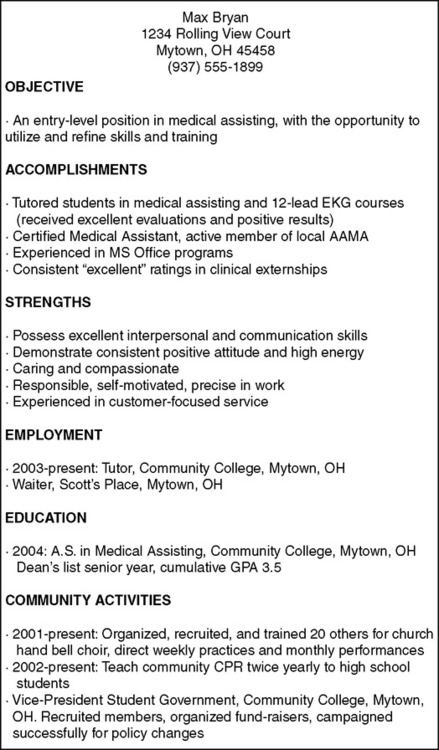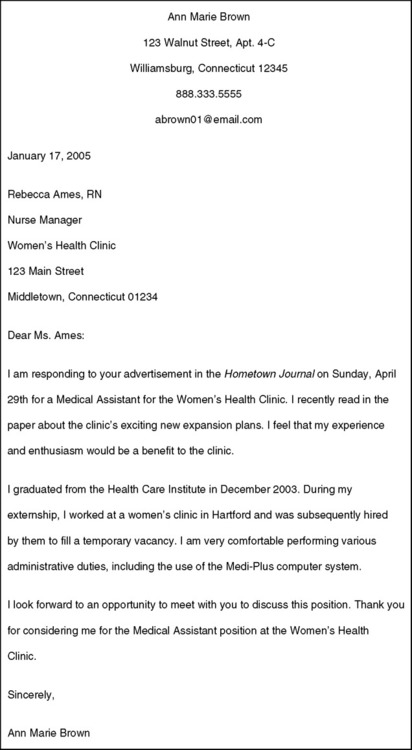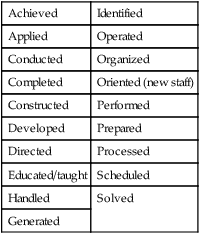Upon successfully completing this chapter, you will be able to: • Describe the components of a resume. • List 10 key action words that can strengthen a resume. • Describe eight practical tips for writing your resume. • State 10 commonly asked interview questions and give possible personal responses. • Describe five practical tips for surviving a job interview. • Explain the purpose for writing a thank-you letter. A standard resume should consist of five components: Here is a closer look at each of these items. If you have an e-mail address, it can be included on the line below the telephone number. Caution: if you list an e-mail address as a communication line, check for messages at least once a day and respond promptly. Be sure that your e-mail address is appropriate. An e-mail address such as badgirls@something.net is not professional and should not be used. • To find a (nursing, medical assisting) position that allows me to work in a medical setting caring for sick children. • To find a challenging and fast-paced position as a (nurse, therapist, medical assistant) in an acute care setting. • I want a job in the medical field. • I am looking for a high paying job in the medical field in New York City. • Do not include your supervisor’s name. • Do not list or explain why you left a position. • Do not overstate your accomplishments. For example, you would not want to say, “Developed, wrote, and published new patient education materials,” unless you actually single-handedly did these three things. Perhaps you were on the committee that revamped patient education material, in which case a better bullet would be, “Participated in patient education committee and helped to recreate and update new patient education materials.” • All health care employers like to see “Cardiopulmonary Resuscitation” certifications. You can become CPR certified through either the American Heart Association or American Red Cross. Generally, it is a 6- to 8-hour course. Even if it is not a job requirement, it shows that you took the initiative to complete the course. • If you have just graduated and are pending licensure or certification results, indicate the month and year that you took the examination and the name of the licensure examination and accrediting agency. For example: “Pending results of Licensed Practical Nurse examination for State of Connecticut, June 2005.” • Before being eligible to sit for a certification examination, you often are required to complete a certain number of clinical hours. In this case, communicate that by writing, “Plan to take (add the name) Certification Examination in June 2005. Completed 50 of the 100 hours of clinical experience required.” • Keep your resume to one page if possible; two is considered maximum. • Emphasize things that you have achieved or accomplished but do not exaggerate or embellish the facts. • Do not mention personal information (such as age, sex, marital status). A chronological resume (Fig. 9-1) is the most commonly used. This format works best for people who have extensive work experience but have been out of school for a while or have a limited educational background. The chronological resume focuses on your progressive work experiences. Following is the order of a chronological resume: 1. Work experiences—List your most recent position and work backwards. Describe your job experiences and responsibilities. A functional resume (Fig. 9-2) lists your skills or accomplishments in categories. This resume is good for people with limited work experiences, new graduates, or people returning to the work force. The focus of a functional resume is on the skills you have and not when or where you obtained these skills. Following is the order of a functional resume: 1. Accomplishments or competencies are listed first. They can be broken into various categories, such as clinical skills, administrative skills, and laboratory skills. Dates or employment records are not assigned to the skill. 2. Employment experiences: List the most recent first and work backwards. List only the dates, job title, and name of the facility. A cover letter (Fig. 9-3) should have the appropriate demographic information, three paragraphs, and a closing. Let’s look at each of these components:
COMMUNICATING TO GET THE JOB YOU WANT: FOUR KEY TOOLS
COMMUNICATION TOOL NUMBER ONE: THE RESUME
Components of a Resume
Demographics
Objective
Work Experience
Awards/Certifications/Licenses
Practical Tips for Creating a Resume
Resume Formats


COMMUNICATION TOOL NUMBER TWO: THE COVER LETTER
Components of a Cover Letter

![]()
Stay updated, free articles. Join our Telegram channel

Full access? Get Clinical Tree


COMMUNICATING TO GET THE JOB YOU WANT: FOUR KEY TOOLS
Only gold members can continue reading. Log In or Register to continue

